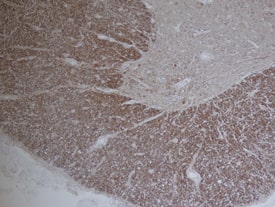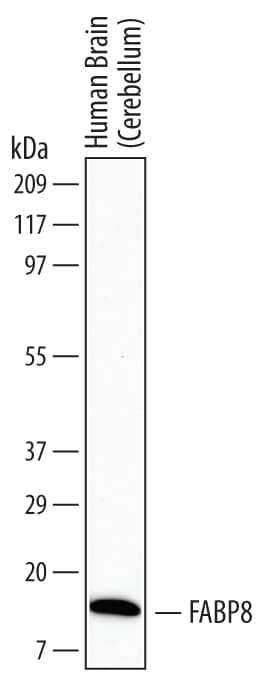FABP8/M-FABP Products
FABP8 (fatty acid binding protein-8; also M [myelin]-FABP, P2 and PMP2) is a 15 kDa (predicted) member of the fatty acid binding protein family, calycin superfamily of molecules. It is found in Schwann cells, presumably on the cytoplasmic face of the plasma membrane where it may contribute to fatty acid transport across myelin. Functionally, FABP8 has a high affinity for U-shaped fatty acids such as oleic and palmitic acid. Human FABP8 is 132 amino acids (aa) in length and exhibits two layers of antiparallel β-strands that envelope a hydrophobic pocket for lipid binding. Arg107 plus Arg127-Ile128-Tyr129 participate in fatty acid binding. Full length human FABP8 shares 87% and 95% aa identity with mouse and rabbit FABP8, respectively.
52 results for "FABP8/M-FABP" in Products
52 results for "FABP8/M-FABP" in Products
FABP8/M-FABP Products
FABP8 (fatty acid binding protein-8; also M [myelin]-FABP, P2 and PMP2) is a 15 kDa (predicted) member of the fatty acid binding protein family, calycin superfamily of molecules. It is found in Schwann cells, presumably on the cytoplasmic face of the plasma membrane where it may contribute to fatty acid transport across myelin. Functionally, FABP8 has a high affinity for U-shaped fatty acids such as oleic and palmitic acid. Human FABP8 is 132 amino acids (aa) in length and exhibits two layers of antiparallel β-strands that envelope a hydrophobic pocket for lipid binding. Arg107 plus Arg127-Ile128-Tyr129 participate in fatty acid binding. Full length human FABP8 shares 87% and 95% aa identity with mouse and rabbit FABP8, respectively.
| Reactivity: | Human |
| Details: | Sheep IgG Polyclonal |
| Applications: | WB, IHC |
| Reactivity: | Human |
| Details: | Mouse IgG1 Monoclonal Clone #631306 |
| Applications: | WB, IHC |
| Source: | E. coli |
| Accession #: | P02689 |
| Reactivity: | Mouse |
| Details: | Rabbit IgG Polyclonal |
| Applications: | WB |
Recombinant Monoclonal Antibody
| Reactivity: | Human |
| Details: | Rabbit IgG Monoclonal Clone #001 |
| Applications: | ELISA |
| Reactivity: | Human |
| Details: | Mouse IgG1 Monoclonal Clone #3H3F4D5 |
| Applications: | ELISA |
| Reactivity: | Human |
| Details: | Rabbit IgG Polyclonal |
| Applications: | ELISA |
| Reactivity: | Human |
| Details: | Rabbit IgG Polyclonal |
| Applications: | ELISA |
Recombinant Monoclonal Antibody
| Reactivity: | Human |
| Details: | Rabbit IgG Monoclonal Clone #001 |
| Applications: | ELISA |
Recombinant Monoclonal Antibody
| Reactivity: | Human |
| Details: | Rabbit IgG Monoclonal Clone #001 |
| Applications: | ELISA |
| Reactivity: | Human |
| Details: | Mouse IgG1 Monoclonal Clone #3H3F4D5 |
| Applications: | ELISA |
| Reactivity: | Human |
| Details: | Mouse IgG1 Monoclonal Clone #3H3F4D5 |
| Applications: | ELISA |
| Reactivity: | Human |
| Details: | Mouse IgG1 Monoclonal Clone #3H3F4D5 |
| Applications: | ELISA |
| Reactivity: | Human |
| Details: | Mouse IgG1 Monoclonal Clone #3H3F4D5 |
| Applications: | ELISA |
| Reactivity: | Human |
| Details: | Mouse IgG1 Monoclonal Clone #3H3F4D5 |
| Applications: | ELISA |
Recombinant Monoclonal Antibody
| Reactivity: | Human |
| Details: | Rabbit IgG Monoclonal Clone #001 |
| Applications: | ELISA |
Recombinant Monoclonal Antibody
| Reactivity: | Human |
| Details: | Rabbit IgG Monoclonal Clone #001 |
| Applications: | ELISA |
Recombinant Monoclonal Antibody
| Reactivity: | Human |
| Details: | Rabbit IgG Monoclonal Clone #001 |
| Applications: | ELISA |
Recombinant Monoclonal Antibody
| Reactivity: | Human |
| Details: | Rabbit IgG Monoclonal Clone #001 |
| Applications: | ELISA |
Recombinant Monoclonal Antibody
| Reactivity: | Human |
| Details: | Rabbit IgG Monoclonal Clone #001 |
| Applications: | ELISA |
Recombinant Monoclonal Antibody
| Reactivity: | Human |
| Details: | Rabbit IgG Monoclonal Clone #001 |
| Applications: | ELISA |
Recombinant Monoclonal Antibody
| Reactivity: | Human |
| Details: | Rabbit IgG Monoclonal Clone #001 |
| Applications: | ELISA |
Recombinant Monoclonal Antibody
| Reactivity: | Human |
| Details: | Rabbit IgG Monoclonal Clone #001 |
| Applications: | ELISA |
Recombinant Monoclonal Antibody
| Reactivity: | Human |
| Details: | Rabbit IgG Monoclonal Clone #001 |
| Applications: | ELISA |
Recombinant Monoclonal Antibody
| Reactivity: | Human |
| Details: | Rabbit IgG Monoclonal Clone #001 |
| Applications: | ELISA |





![Western Blot: FABP8/M-FABP/Myelin P2 Protein AntibodyBSA Free [NBP3-03262] Western Blot: FABP8/M-FABP/Myelin P2 Protein AntibodyBSA Free [NBP3-03262]](https://resources.bio-techne.com/images/products/FABP8-M-FABP-Myelin-P2-Protein-Antibody-Western-Blot-NBP3-03262-img0001.jpg)
